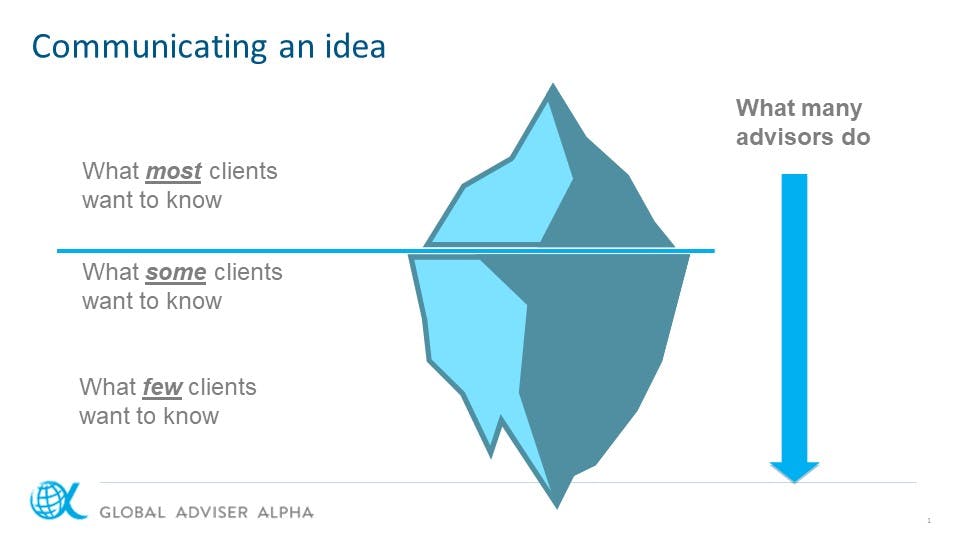
You’ve nailed your investment philosophy. You’re clear on where you add value as an adviser. Now, the next step. How do you communicate all that? The answer lies as much in the structure and process of your communication efforts as in the words themselves.
Let me explain. Remember the last time you got really enthusiastic about something? It might have been a new approach to barbecuing, a bingeworthy series on Netflix or the wonders of a new mobile phone app. But you wanted to tell everyone everything about it, right?
The risk in circumstances like these is that your own enthusiasm is such that you bore the audience. They can see that you’re passionate about the new braising method, or series plotline or functions of your favourite app, but they’re not sure how it connects to their lives.
This is a mistake that advisers frequently make when they embrace a new investment philosophy. Because it’s a brave new world for them, they want to share the wonders of their experience with everyone down to the very last detail.
Building a Process
So, stop right there. The way to think about communicating to clients is to quit the presumption that you are going to reinvent the wheel. This is a process like any other. And it will be a lot easier for you, and your clients, if you build a simple, client-centric structure around it.
The iceberg analogy is a good place to start. As much as you might want to show off your new-found knowledge of modern portfolio theory and the cross-sectional dispersion of stock returns, chances are what clients want to know will be at the pointy end of the iceberg.
For instance: Do you understand their challenges and goals? Can you help them with a plan to meet them? What is your process? How will you measure success? What do you need from them? Those questions typically reside in the part of the iceberg sticking out of the water.

Now, of course, each of those questions can lead to deeper ones that may start to intrude on the deeper below-the-waterline technical issues around risk and volatility and returns dispersion and diversification and asset allocation. But those are the means, not the ends.
Think about when you put your car into the garage to get fixed. You want to know broadly what the problem is, how much it will cost to repair and how long it will take. The outcome you want is a car that gets you reliably and safely to your destination. Unless you are mechanically minded, you are not particularly interested in whether your braking and steering problems are due to torque variation or a fluid leak. You just don’t want the car to crash.
It’s a similar approach with financial advice. Sure, there will be engineering-minded clients who will be ready to talk all day about options pricing and stochastics if you give them half a chance, but that’s not going to get them any closer to fixing their problem.
This isn’t to say you shouldn’t have the technical detail in your back pocket should it come up, but the investment philosophy and your methodology are not topics to lead with in client meetings, certainly not in the discovery meeting.
Different Folks, Different Strokes
Your investment philosophy can be communicated in many different ways – through a short video on your website where you talk about your own story, through presentation slides that lead clients through the process you follow, through blog posts that weave your ideas into analogies and real-life examples, and through white papers for the nerdier clients.
The point is that because people absorb information in many varied ways, it makes sense to offer them different pathways to the same essential messages. Giving people choices in how they understand what you do and how is only going to make them more receptive.
Let me give you an example. Ask this simple question at the strategy meeting: “We have this investment piece we’d like to run you through today. Would you like the short version, the medium version or the long version?” You’ll find 99% of people will opt for the short version. In any case, hopefully they watched your six-minute video on your website beforehand and that gave them the overall gist of what you do.
For the client who wants to go deeper, you can supplement the short version with the PowerPoint presentation and a white paper to take home. “Remember, we’re going to be testing you on that at the next meeting!” (Some people actually appear to like that!)
Build it Gradually
So as a first step in developing your communication process, I would build a bullet point list of your beliefs and their value to the client. Assemble no more than 10 PowerPoint slides and put the technical detail in the appendix. Leave your investment philosophy discussion out of the discovery meeting, but have it in reserve if asked.
In the medium term, you may want to put together a self-authored white paper that includes quotes and references to the source material underpinning your philosophy. The idea is to build layers of depth into your communication materials, each pointing to the other.
Longer term, produce a high quality video where you tell your story, what you have discovered about investing and how you connect that to good client outcomes. Send the link to the video to clients and prospects before the meeting.
Throughout, emphasise a ‘Life-First’ approach. It starts with the client and their challenges and circumstances, not with the investment approach. Save the meetings for discussion with clients about their lives, not for filling out questionnaires or forms. That can be done before or after.
The Ultimate Goal
If you are succeeding at this, you will gradually strip away and simplify the detail of the investment philosophy and approach so that these become purely a means to an end, not the end in itself as it might first have appeared in the dark days before you set your philosophy.

Ultimately, good communication is not one thing. And that is because humans are all different. We learn differently and we absorb messages in a broad number of ways. Your communications strategy will succeed if you start from that principle - keep the client in mind, and connect what you have discovered and embraced to the goal of helping them meet their challenges.
The takeout is that good communication is the basis of strong, productive relationships. And in an industry built around people, that is why getting communication right is so very important.
----
Need help to build your investment philosophy or CVP out? Our Program can help.
Information on our Program
While many practices survive, they don’t thrive in the way their principals imagined when they set out. What about you?
- Poor work life balance?
- Limited Growth?
- Too little profit?
- Limited earning?
There is a better way. Is this your time to move to a more successful future?
I have helped thousands of professionals to:
- Achieve significant growth in revenue and profitability
- Build or improve systems and processes and be more in control
- Attract and retain the right clients and team members, and
- Move from a practice to a genuine business
The Program includes 6 modules, over 27 videos, over 38 global best practice templates, scripts and agendas, along with quizzes, FAQ and text. All that can be worked through and implemented at your own pace and timeline.
All for the cost of less than one new client.
Why wait? To invest in your future, the time is now.
For further information on the Online Program or to join, click here.
Any questions, email david@globaladviseralpha.com